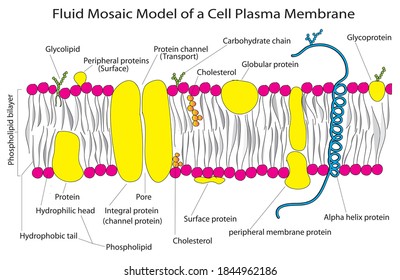The Fluid-Mosaic Model of the Cell Plasma Membrane The fluid-mosaic model describes the plasma membrane of animal cells. The cell membrane does a lot for the cell.
 Fluid Mosaic Model High Res Stock Images Shutterstock
Fluid Mosaic Model High Res Stock Images Shutterstock
The Fluid Mosaic Model of the Structure of Cell Membranes Cell membranes are viewed as two-dimensional solutions of oriented globular proteins and lipids.

Fluid mosaic model cell membrane. The Fluid part represents how some parts of the membrane can move around freely if they are not attached to other parts of the cell. Plasma membranes range from 5 to 10 nm in thickness. The fluid mosaic model describes the cell membrane as a tapestry of several types of molecules phospholipids cholesterols and proteins that are constantly moving.
The plasma membrane that surrounds these cells has two layers a bilayer of phospholipids fats with phosphorous attached which at body temperature are like vegetable oil fluid. Who Proposed Fluid Mosaic Model. Fluid Mosaic Model April 5 2019 by Sagar Aryal Table of Contents The Fluid Mosaic Model of Biomembranes Figure.
Fluid Mosaic Model. Plasma membranes range from 5 to 10 nm in thickness. It describes the structure of cell membranes where a flexible lipid layer is spread with large protein molecules that act as channels through which other molecules enter and exit any cell.
The fluid mosaic model describes the structure of the plasma membrane as a mosaic of components including phospholipids cholesterol proteins and carbohydratesthat gives the membrane a fluid character. Fluid mosaic model definition. A short video on the Fluid Mosaic Model of the cell membrane.
This movement helps the cell membrane maintain its role as a barrier between the inside and outside of the cell environments. Specifically you will be assessed on your knowledge of cell communication intercellular space cell to cell adhesion and the Fluid Mosaic Model. They are a special type of membranes which are lipid structures that separate the cell from.
References The plasma membrane also known as the cell surface membrane or plasmalemma defines the boundary of the cell. The fluid mosaic model of the cell membrane is how scientists describe what the cell membrane looks and functions like because it is made up of a bunch of different molecules that are distributed across the membrane. Singer and Garth L.
Fluid mosaic model of a cell membrane Source. The Fluid Mosaic Model states that membranes are composed of a Phospholipid Bilayer with various protein molecules floating around within it. A short video on the Fluid Mosaic Model of the cell membrane.
The cell membrane also known as the plasma membrane PM or cytoplasmic membrane and historically referred to as the plasmalemma is a biological membrane. The fluid mosaic model of cell membrane was first proposed by SJ. The model is consistent with the restrictions imposed by.
The model has evolved. A fluid mosaic model is presented for the gross organization and structure of the proteins and lipids of biological membranes. One may also ask why is fluid mosaic model important.
Singer and Garth L. Nicolson proposed a new model of the plasma membrane that compared to earlier understanding better explained both microscopic observations and the function of the plasma membrane. The fluid mosaic model describes the structure of the plasma membrane as a mosaic of components including phospholipids cholesterol proteins and carbohydratesthat gives the membrane a fluid character.
The fluid mosaic model describes the structure of the plasma membrane as a mosaic of components including phospholipids cholesterol proteins and carbohydratesthat gives the membrane a fluid character. This was called the fluid mosaic model.